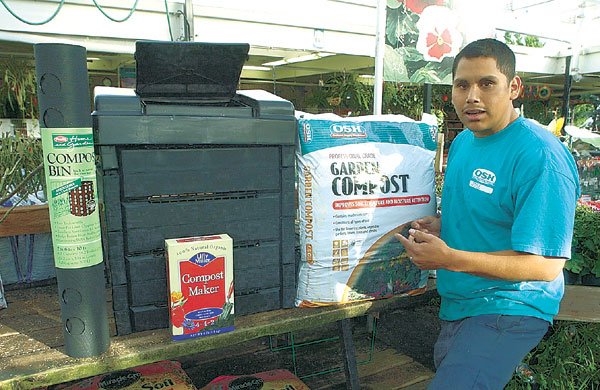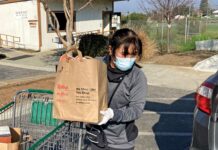Composting is more than simply smooshing together some materials
and hoping they’ll make plants grow. It involves planning and care,
but according to some gardeners, the results are well worth the
effort
Make your leftover coffee grounds, egg shells and dryer lint work for you. Composting these and other biodegradable items such as lawn mowings, vegetable scraps and even this newspaper can help to make your home garden a lush paradise.
Composting is putting biodegradable materials in a pile where they break down and decompose together, eventually becoming nutrient-rich soil, said Monica Roorda, a Gilroy resident who maintains three large compost piles on her property.
“Composting is wonderful, and it’s not hard to do,” she said. “The grass clippings from mowing the lawn go on the piles to keep them moist. We put branches, twigs, vegetables, leaves and all kinds of stuff in there. Then I use the compost in my gardening.”
To make a compost pile, pick a location that isn’t on concrete and isn’t next to your home or other structures, according to the composting-information Web site www.mastercomposter.com. Putting the pile on concrete would prevent earthworms and other insects from coming up through the ground to help break down the pile, and putting the pile too close to a structure may lead to bugs and critters coming into your home.
Gardeners can use a compost bin, available at most hardware stores and garden centers, if they choose, but it’s not necessary. Bins will help keep the pile looking neat and may help retain heat and moisture, but Roorda said she built three-sided, open-topped structures for her piles, which work well for her.
Composting is about having a good balance of two things: nitrogens, meaning green waste including grass and vegetables; and carbons, meaning brown waste including dry hay, leaves and branches.
To speed the composting process, build a pile and then leave it alone. Start a new pile with any additional organic waste, said Pat Herbert, co-owner of Herbert Family Organic Farm in Hollister with his wife, Patti. Continuing to add new waste to an existing pile will slow the decomposition process greatly. A pile left to break down without having new waste added will turn to soil in about eight to 10 weeks.
Covering the pile is optional, and a plastic garbage bag may help prevent piles getting too wet during rainy season. The pile should become hot, especially toward the center within a few days of it being left alone, Roorda said. If it’s kept slightly moist and the balance of nutrients is correct, piles will often start to steam. A compost pile should be as moist as a wrung-out sponge. Turning the pile is also optional, and doing so can help increase aeration and make sure all of the materials are exposed to the hot center.
Herbert Family Organic Farm makes thousands of tons of compost from feed straw, yard waste from San Jose and manure from a local dairy, among other materials.
“Compost solves so many problems, I can go on and on,” Herbert said. “It balances soil, acts as a fertilizer, introduces aerobic microbes that prevent disease and insects in plants. It increases water holding capacity … there are a lot of benefits.”
Troubleshooting Composting Problems
-Problem: The pile is damp and warm only in the middle.
-Solution: The pile could be too small, or cold weather might have slowed composting. If you are only composting in piles, make sure your pile is at least 3 feet high and 3 feet wide. With a bin, the pile doesn’t need to be so large.
-Problem: Nothing is happening. The pile doesn’t seem to be heating up at all.
-Solution: This could be cause by several things, such as:
1. not enough nitrogen
2. not enough oxygen
3. not enough moisture
4. cold weather
5. the compost is finished.
Check to …
1. Make sure you have enough nitrogen-rich sources such as manure, grass clippings or food scraps.
2. Mix up the pile so it can breathe.
3. Mix up the pile and water it with the hose so that there is some moisture in the pile. A pile that is fully dry won’t compost.
4. Wait for spring, cover the pile or use a bin.
-Problem: The matted leaves or grass clippings aren’t decomposing.
-Solution: The pile has poor aeration or lack of moisture. Avoid thick layers of just one material. Too much of one substance such as leaves, paper or grass clippings don’t break down well. Break up the layers and mix up the pile so there is a good mix of materials. Shred any big material that isn’t breaking down well.
-Problem: The pile stinks like rancid butter, vinegar or rotten eggs.
-Solution: Not enough oxygen is getting to the pile, or the pile is too wet or compacted. Mix up the pile so it gets some aeration and can breathe. Add coarse, dry materials such as straw, hay or leaves to soak up excess moisture. If the smell is too bad, add dry materials on top and wait until it dries out a bit before you mix the pile.
-Problem: The pile emits an odor similar to ammonia.
-Solution: There’s not enough carbon. Add brown materials such as leaves, straw, hay, shredded newspaper, etc.
-Problem: The pile is attracting rodents, flies or other creatures.
-Solution: Inappropriate materials such as meat, oil and bones have been added to the pile, or the food-like material is too close to the surface of the pile. Bury kitchen scraps near the center of the pile. Don’t add inappropriate materials to compost. Switch to a rodent-proof, closed bin.
-Problem: The pile is attracting insects, millipedes, slugs, etc.
-Solution: This is normal composting and part of the natural process. It’s not a problem.
-Problem: The pile is attracting fire ants.
-Solution: The pile could be too dry, not hot enough or has kitchen scraps too close to the surface. Make sure your pile has a good mix of materials to heat up, and keep it moist enough.
Put on the composting Pile:
Algae, seaweed and lake moss
Cardboard
Coffee grounds and filters
Cornstalks, corn cobs
Dryer Lint
Egg shells
Hair
Manure from horses, cows, pigs, sheep, goats, chickens and rabbits
Newspaper (shredded)
Oak leaves
Sawdust and wood shavings from untreated wood
Pine needles and cones
Don’t Put on the composting Pile:
Meat
Fat
Grease
Oils
Bones
Lime
Fish scraps
Dog and cat droppings
Cat litter
Ashes from coal or charcoal
Source: www.compostguide.com












